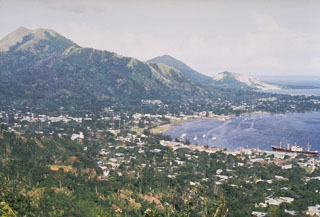Report on Rabaul (Papua New Guinea) — 23 January-29 January 2008
Smithsonian Institution / US Geological Survey
Weekly Volcanic Activity Report, 23 January-29 January 2008
Managing Editor: Sally Sennert.
Please cite this report as:
Global Volcanism Program, 2008. Report on Rabaul (Papua New Guinea) (Sennert, S, ed.). Weekly Volcanic Activity Report, 23 January-29 January 2008. Smithsonian Institution and US Geological Survey.
Rabaul
Papua New Guinea
4.2459°S, 152.1937°E; summit elev. 688 m
All times are local (unless otherwise noted)
RVO reported that white plumes from Rabaul caldera's Tavurvur cone rose to an altitude of 1.5 km (4,900 ft) a.s.l. and drifted E and NE during 24-25 January. Incandescence at the summit was seen at night. On 26 January, ash plumes that were emitted about every 10-20 minutes rose to an altitude of 1.7 km (5,600 ft) a.s.l. and drifted NE. Slight ashfall was reported in areas on the E coast. Deformation-monitoring instruments indicated that uplift started on 23 January and peaked during 25-26 January with 2 cm of inflation. On 28 January, white plumes rose to an altitude of 1.7 km (5,600 ft) a.s.l. and drifted W. On 29 and 30 January, ash-and-gas plumes rose to the same altitude as the previous day but drifted SW, W, and E.
Geological Summary. The low-lying Rabaul caldera on the tip of the Gazelle Peninsula at the NE end of New Britain forms a broad sheltered harbor utilized by what was the island's largest city prior to a major eruption in 1994. The outer flanks of the asymmetrical shield volcano are formed by thick pyroclastic-flow deposits. The 8 x 14 km caldera is widely breached on the east, where its floor is flooded by Blanche Bay and was formed about 1,400 years ago. An earlier caldera-forming eruption about 7,100 years ago is thought to have originated from Tavui caldera, offshore to the north. Three small stratovolcanoes lie outside the N and NE caldera rims. Post-caldera eruptions built basaltic-to-dacitic pyroclastic cones on the caldera floor near the NE and W caldera walls. Several of these, including Vulcan cone, which was formed during a large eruption in 1878, have produced major explosive activity during historical time. A powerful explosive eruption in 1994 occurred simultaneously from Vulcan and Tavurvur volcanoes and forced the temporary abandonment of Rabaul city.
Source: Rabaul Volcano Observatory (RVO)

